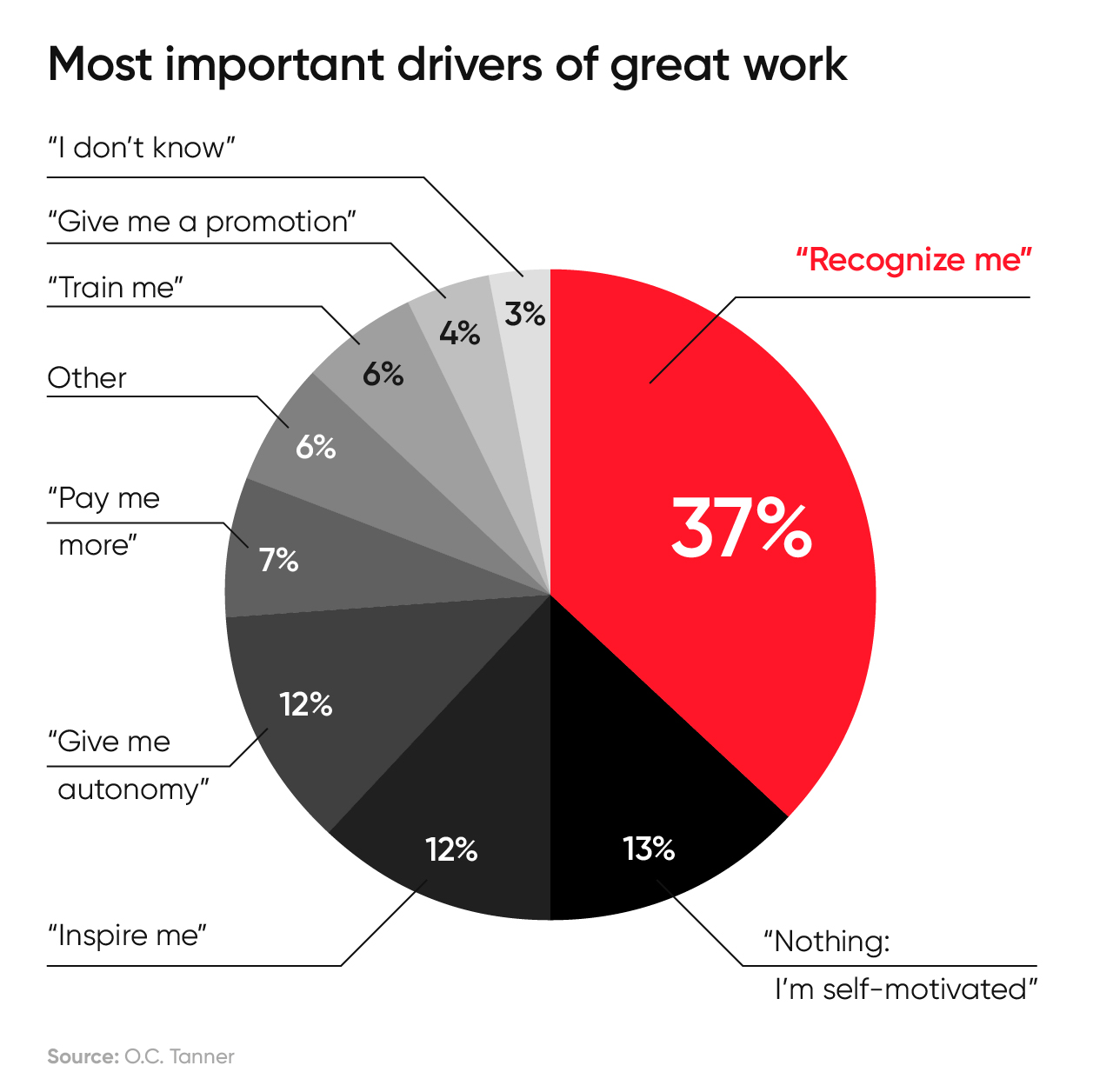We all know this familiar scenario:
Your team welcomes a new employee who is motivated and bursting with new ideas. But as the days pass into months, their enthusiasm and energy plateaus, and inevitably plummets.
One reason for this is a lack of appreciation, and it’s why so many organizations find it an ongoing battle to keep their staff engaged and motivated.
A lot of leaders may think that an appreciation message is enough to keep staff in good spirits, but in truth, it takes far more than that.
While it’s helpful to send regular, personalized messages of recognition and appreciation, there’s much more you can do to boost engagement, morale, and loyalty in your organization.
An article of the hierarchy of employees’ needs shows that at the bottom is the need for benefits and pay, followed by developmental opportunities, and the possibility of a promotion.
Next in the hierarchy is feeling respected and appreciated in their role, and finally, their sense of common purpose and connection in the company.
So, as you can see, employee appreciation is very important, and the good news is that there are a lot of opportunities for managers to keep their staff motivated and happy than simply writing an appreciation message. And the best way is through tangible forms of recognition.
Read the rest of this article to discover what you can do to keep your employees happy and engaged.
Why Employee Recognition is Important
Employee appreciation refers to words and actions that an employer, peers, or colleagues show in acknowledgment of another team member’s work.
Feeling appreciated is a fundamental human need, and consistently showing employees appreciation impacts their happiness at work.
Good leaders understand that employees want to receive recognition and be rewarded every time they hit their goals or achieve something. When certain productive behavior is reinforced and recognized, it will, in turn, keep employees happy and bring about positive business results.
Here’s an image that explains how important employee recognition really is:
Employees whose work and efforts are taken for granted by their leadership often do not go above and beyond to increase productivity.
Workers become motivated when someone else sees their work as being valuable to the company. When employees’ work is recognized, their productivity and satisfaction rise, keeping them motivated to improve or maintain their good work.
It’s important to recognize that showing recognition in the right way at the time and in the way the employee best receives that expression may help you cut variable expenses.
Instead of just spending money on something like a gym membership or piece of software the employee won’t ever use, you can talk to them about their needs, desires, and what it is that they actually need to live a more productive and happier life.
How To Give Employee Recognition In The Way They Need
Although giving tangible rewards can make a huge difference in how employees perceive your message of appreciation, a simple, genuine “thank you” or an appreciation message should always be your first choice.
It’s often what an employee needs to feel their input is valued and keeps them motivated to try harder. In addition to letting them know how much their efforts are valued, you can also use additional, tangible rewards as a way to reinforce your message.
This also has additional benefits. Simply saying “thank you”, without adding some sort of tangible reward may be perceived by employees as platitudes without any real meaning.
This can lead to an organizational culture of cynicism and distrust which could ultimately result in a lot of negative consequences.
For example, some workers might leave the company because of this.
Yet others might be so frustrated that they complain or speak poorly about the organization on social media, which is bad for the company’s reputation. If such complaints go viral, it could even affect the organization’s ability to hire new employees.
That’s why it’s crucial for managers to not only tell employees that you appreciate them, but also show it with compensation (monetary or otherwise).
Start with Praise
Not only do all employees crave for their management to appreciate them, but for management to not be afraid to show it, whether it be in terms of a paycheck or taking them out of the office.
A wildly effective strategy that is underused, is giving an employee praise that is specific and that highlights their unique contribution to the company or a certain project.
Let’s have a look at some examples of compliments you could give employees:
- You maintain the best attitude even when things are tough.
- I can’t imagine working without you!
- You continue to impress me with the results you produce.
- You’re so flexible, thank you!
- Thank you for continually providing a unique viewpoint.
- You’re always willing to lend a hand.
- You are great to work with!
- You have a great work ethic and it speaks for itself.
- It makes a huge difference having you on our team.
- Fantastic work!
Another thing to keep in mind is how you give these compliments.
Appreciation messages can be sent in a greeting card, via a personalized email with a catchy subject line, or over the phone, but mentioning it during staff meetings or a public session has a special effect on the employees’ morale .
Having employee appreciation presented in front of peers motivates the employee and inspires others to work harder to also receive appreciation.
Presenting appreciation publically doesn’t have to necessarily be an in-person affair nor does it have to disrupt the traditional workday. For remote and hybrid workers, true face-to-face engagement may be impossible.
However, when using workplace webinar software for meetings, you can express appreciation or announce successes at the workplace.
In fact, you might even consider making it a regular policy to announce worker successes to show that you really do care about the work they complete for the company.
Tangible Ways to Show Employee Appreciation
There are also many tangible ways If you are baffled on ways to express employee appreciation and show gratitude for their hard work. When the right rewards are given at the right time, employees can feel not only appreciated in a general way but also in a personalized way.
Find out what your employees are interested in and what could be of use to them in their professional and personal life. Sometimes, it’s just as easy to ask them.
Here are a few tangible things that you should consider using to reward your employees and express your appreciation generally and for specific accomplishments:
- Branded company merch (e.g. custom coffee mug)
- Gift cards (Amazon, restaurant, spa, etc.)
- Travel vouchers
- Scheduled pay raise or unscheduled cash bonuses
- Offer free subscriptions to leading online courses platforms, video or music editing software, exclusive podcast directories and screen recorder software, or SaaS that might be of interest to the employee.
- Membership to a gym, fitness center, or country club
- A basket of goodies like fruit, muffins, cookies, or other edible delights
- Paid time Off
- Chair massages or nap pods for usage in the office
- Free Lunch
- Cooking lessons
- Uber/Lyft Credit
- Flexible work hours with opportunities for remote and hybrid work
Does Rewarding Employees Really Work?
This is a good question. Does it really pay off to show your employees appreciation or are you using company resources in vain?
It’s true that employees get paid for their work, however, it shouldn’t be a reason for you to forgo appreciating employee efforts that they put in their work.
Consider having an appreciation program.
Having an active appreciation program helps people feel valued while giving them a personal purpose for them to do their best and not just put in the minimal time or effort.
This program will result in a positive environment to work in, and over time, your work team creates bonds and learns to rely on each other during work challenges and tasks. During tough times, employees will know there is someone to help them out, this boosts their morale.
If you haven’t got a recognition and rewards program running, here are some reasons why you should:
- Increases Motivation: This type of program increases motivation and engagement in employees so they stay on track and have an increased positive attitude. It gives them something to work toward and they offer greater effort.
- Shows Appreciation: It sends out a message that they are valuable to the company and helps them feel seen. Happy workers are workers who want to work harder and help the company succeed.
- Encourages Friendly Competition: An employee rewards program also encourages competition amongst coworkers as they strive to do better than their colleagues and perform better than the others who were previously acknowledged.
- Creates a Positive Workplace: The positive energy from happy workers becomes contagious, making the workplace a place of enthusiastic people.
Giving your employees the opportunity to recognize each other and encourage one another gets everyone invested in appreciation and paves the foundation for teams to build strong bonds, in turn, increasing employee engagement and retention in the long run.
Some interesting ways that appreciation and recognition impact employees is shown below:
The Negative Impact of Having Unhappy Workers
Employee recognition and appreciation keep your team happy, but what happens when employees are not happy?
Increased staff turnover rates are one of the most common effects of unhappy employees. When a person feels unappreciated they usually take the initiative to leave the company and go where they will feel more valued. Happy employees tend to stick around longer.
Having unsatisfying performance results is another common effect. Workers will put minimal effort into their work when they know they are not being appreciated for putting in the extra effort to their work.
A poor team culture happens when no one is eager to uplift or encourage their colleague to excel. If no one is being appreciated for their achievement, soon the negativity of poor workmanship will spread throughout the company and create a culture of passivity.
Conclusion
One of the most crucial changes you could make to further your organization is driving employee engagement. There’s no fast or hard rule about what drives employee engagement but we know that it is vital to the development of your company.
In fact, companies with happy employees perform better than companies with disengaged teams. So use the information in this article to help you show appreciation to your workers in effective ways that will truly keep them happy.
What are other ways you use to keep your employees happy? Share your ideas in the comments section below!







Leave A Comment